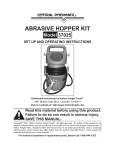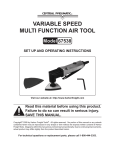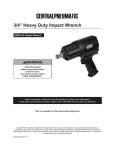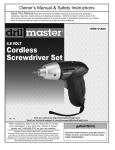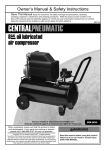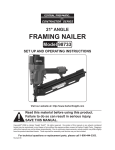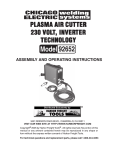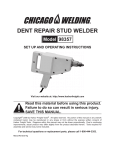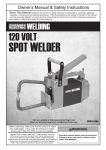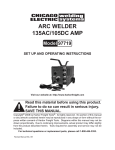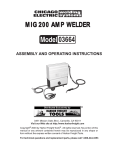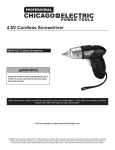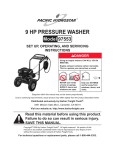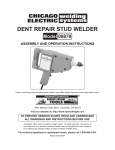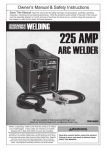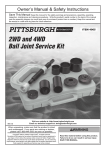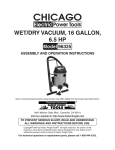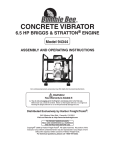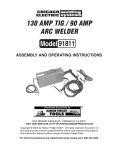Download Harbor Freight Tools 80 Amp_DC, 120 Volt, Inverter Stick Welder Product manual
Transcript
1. Work area safety Save This Manual Keep this manual for the safety warnings and precautions, assembly, operating, inspection, maintenance and cleaning procedures. Write the product’s serial number in the back of the manual near the assembly diagram (or month and year of purchase if product has no number). Keep this manual and the receipt in a safe and dry place for future reference. IMPORTANT SAFETY INFORMATION In this manual, on the labeling, and all other information provided with this product: This is the safety alert symbol. It is used to alert you to potential personal injury hazards. Obey all safety messages that follow this symbol to avoid possible injury or death. a.Keep work area clean and well lit. Cluttered or dark areas invite accidents. b.Do not operate welders in explosive atmospheres, such as in the presence of flammable liquids, gases or dust. Welders create sparks which may ignite the dust or fumes. c.Keep children and bystanders away while operating a welder. Distractions can cause you to lose control. 2. Electrical safety a.Welder plugs must match the outlet. Never modify the plug in any way. Do not use any adapter plugs with grounded welders. Unmodified plugs and matching outlets will reduce risk of electric shock. b.Avoid body contact with grounded surfaces such as pipes, radiators, ranges and refrigerators. There is an increased risk of electric shock if your body is grounded. c.Do not expose welders to rain or wet conditions. Water entering a welder will increase the risk of electric shock. DANGER indicates a hazardous situation which, if not avoided, will result in death or serious injury. d.Do not abuse the cord. Never use the cord for carrying, pulling or unplugging the welder. Keep cord away from heat, oil, sharp edges or moving parts. Damaged or entangled cords increase the risk of electric shock. WARNING indicates a hazardous situation which, if not avoided, could result in death or serious injury. e.When operating a welder outdoors, use an extension cord suitable for outdoor use. Use of a cord suitable for outdoor use reduces the risk of electric shock. CAUTION, used with the safety alert symbol, indicates a hazardous situation which, if not avoided, could result in minor or moderate injury. f. If operating a welder in a damp location is unavoidable, use a Ground Fault Circuit Interrupter (GFCI) protected supply. Use of a GFCI reduces the risk of electric shock. NOTICE is used to address practices not related to personal injury. CAUTION, without the safety alert symbol, is used to address practices not related to personal injury. General Safety Warnings WARNING Read all safety warnings and instructions. Failure to follow the warnings and instructions may result in electric shock, fire and/ or serious injury. Save all warnings and instructions for future reference. Page 2 For technical questions, please call 1-888-866-5797. Item 61749 3. Personal safety 4. Welder use and care a.Stay alert, watch what you are doing and use common sense when operating a welder. Do not use a welder while you are tired or under the influence of drugs, alcohol or medication. A moment of inattention while operating welders may result in serious personal injury. b.Use safety equipment. Always wear ANSI‑approved safety glasses and arc shaded, impact safety full face shield. Safety equipment such as NIOSH-approved respirator, heavy-duty work gloves, non-skid safety shoes, or hearing protection used for appropriate conditions will reduce personal injuries. c.Prevent unintentional starting. Ensure the switch is in the off-position before connecting to power source or moving the welder. Carrying or energizing welders that have the switch on invites accidents. d.Do not overreach. Keep proper footing and balance at all times. This enables better control of the welder in unexpected situations. e.Only use safety equipment that has been approved by an appropriate standards agency. Unapproved safety equipment may not provide adequate protection. Eye protection must be ANSIapproved and breathing protection must be NIOSHapproved for the specific hazards in the work area. a.Do not use the welder if the switch does not turn it on and off. Any welder that cannot be controlled with the switch is dangerous and must be repaired. b.Disconnect the plug from the power source before making any adjustments, changing accessories, or storing welders. Such preventive safety measures reduce the risk of starting the welder accidentally. c.Store idle welders out of the reach of children and do not allow persons unfamiliar with the welder or these instructions to operate the welder. Welders are dangerous in the hands of untrained users. d.Maintain welders. Check for misalignment or binding of moving parts, breakage of parts and any other condition that may affect the welder’s operation. If damaged, have the welder repaired before use. Many accidents are caused by poorly maintained welders. e.Use the welder and accessories in accordance with these instructions, taking into account the working conditions and the work to be performed. Use of the welder for operations different from those intended could result in a hazardous situation. 5. Service a.Have your welder serviced by a qualified repair person using only identical replacement parts. This will ensure that the safety of the welder is maintained. Item 61749 For technical questions, please call 1-888-866-5797. Page 3 Welder Safety Warnings 1. Maintain labels and nameplates on the Welder. These carry important information. If unreadable or missing, contact Harbor Freight Tools for a replacement. 2. Maintain a safe working environment. Keep the work area well lit. Make sure there is adequate surrounding workspace. Always keep the work area free of obstructions, grease, oil, trash, and other debris. 7. Prevent accidental fires. Remove any combustible material from the work area. • When possible, move the work to a location well away from combustible materials. If relocation is not possible, protect the combustibles with a cover made of fire resistant material. 3. Avoid unintentional starting. Make sure you are prepared to begin work before turning on the Welder. • Remove or make safe all combustible materials for a radius of 35 feet (10 meters) around the work area. Use a fire resistant material to cover or block all open doorways, windows, cracks, and other openings. 4. Unplug before performing maintenance. Unplug the Welder from its electrical outlet before performing any inspection, maintenance, or cleaning procedures. • Enclose the work area with portable fire resistant screens. Protect combustible walls, ceilings, floors, etc., from sparks and heat with fire resistant covers. 5. Never leave the Welder unattended while energized. Turn power off if you have to leave the Welder. Prevent eye injury and burns. Wearing and using ANSI-approved personal safety clothing and safety devices reduce the risk for injury. 6. • If working on a metal wall, ceiling, etc., prevent ignition of combustibles on the other side by moving the combustibles to a safe location. If relocation of combustibles is not possible, designate someone to serve as a fire watch, equipped with a fire extinguisher, during the cutting process and for at least one half hour after the cutting is completed. • Wear ANSI-approved safety impact eye goggles underneath welding eye protection featuring at least a number 10 shade lens rating, such as the one included. • Do not weld or cut on materials having a combustible coating or combustible internal structure, as in walls or ceilings, without an approved method for eliminating the hazard. • Leather leggings, fire resistant shoes or boots should be worn when using this product. Do not wear pants with cuffs, shirts with open pockets, or any clothing that can catch and hold molten metal or sparks. • Do not dispose of hot slag in containers holding combustible materials. Keep a fire extinguisher nearby and know how to use it. • Keep clothing free of grease, oil, solvents, or any flammable substances. Wear dry, insulating gloves and protective clothing. • Wear an approved head covering to protect the head and neck. Use aprons, cape, sleeves, shoulder covers, and bibs designed and approved for welding and cutting procedures. • When welding/cutting overhead or in confined spaces, wear flame resistant ear plugs or ear muffs to keep sparks out of ears. Page 4 • After spot welding, make a thorough examination for evidence of fire. Be aware that easily visible smoke or flame may not be present for some time after the fire has started. Do not weld or cut in atmospheres containing dangerously reactive or flammable gases, vapors, liquids, and dust. Provide adequate ventilation in work areas to prevent accumulation of flammable gases, vapors, and dust. Do not apply heat to a container that has held an unknown substance or a combustible material whose contents, when heated, can produce flammable or explosive vapors. Clean and purge containers before applying heat. Vent closed containers, including castings, before preheating, welding, or cutting. For technical questions, please call 1-888-866-5797. Item 61749 8. Avoid overexposure to fumes and gases. Always keep your head out of the fumes. Do not breathe the fumes. Use enough ventilation or exhaust, or both, to keep fumes and gases from your breathing zone and general area. • Where ventilation is questionable, have a qualified technician take an air sampling to determine the need for corrective measures. Use mechanical ventilation to improve air quality. If engineering controls are not feasible, use an approved respirator. • Work in a confined area only if it is well-ventilated, or while wearing an air-supplied respirator. • Follow OSHA guidelines for Permissible Exposure Limits (PEL’s) for various fumes and gases. • Follow the American Conference of Governmental Industrial Hygienists recommendations for Threshold Limit Values (TLV’s) for fumes and gases. • Have a recognized specialist in Industrial Hygiene or Environmental Services check the operation and air quality and make recommendations for the specific welding or cutting situation. 9. INHALATION HAZARD: Welding and Plasma Cutting Produce TOXIC FUMES. Exposure to welding or cutting exhaust fumes can increase the risk of developing certain cancers, such as cancer of the larynx and lung cancer. Also, some diseases that may be linked to exposure to welding or plasma cutting exhaust fumes are: • Early onset of Parkinson’s Disease •Heart disease •Ulcers • Damage to the reproductive organs • Inflammation of the small intestine or stomach • Kidney damage • Respiratory diseases such as emphysema, bronchitis, or pneumonia Use natural or forced air ventilation and wear a respirator approved by NIOSH to protect against the fumes produced to reduce the risk of developing the above illnesses. Item 61749 10. Do not touch live electrical parts. Wear dry, insulating gloves. Do not touch Electrode or Electrode Clamp with bare hand. Do not wear wet or damaged gloves. 11. Protect yourself from electric shock. Do not use outdoors. Insulate yourself from the workpiece and ground. Use nonflammable, dry insulating material if possible, or use dry rubber mats, dry wood or plywood, or other dry insulating material big enough to cover your full area of contact with the work or ground. 12. People with pacemakers should consult their physician(s) before using this product. Electromagnetic fields in close proximity to a heart pacemaker could cause interference to, or failure of the pacemaker. 13. Use care not to touch the welding tip to grounded material whenever the unit is plugged in. Electric shock, fire, or burns may happen if appropriate precautions are not taken. 14. Ensure that the unit is placed on a stable location before use. If this unit falls while plugged in, severe injury, electric shock, or fire may result. 15. This product, when used for welding and similar applications, contains or produces a chemical known to the State of California to cause cancer and birth defects (or other reproductive harm). (California Health & Safety Code § 25249.5, et seq.) 16. Handling the cord on this product will expose you to lead, a chemical known to the State of California to cause cancer, and birth defects or other reproductive harm. Wash hands after handling. (California Health & Safety Code § 25249.5, et seq.) 17. The warnings, precautions, and instructions discussed in this instruction manual cannot cover all possible conditions and situations that may occur. It must be understood by the operator that common sense and caution are factors which cannot be built into this product, but must be supplied by the operator. SAVE THESE INSTRUCTIONS. For technical questions, please call 1-888-866-5797. Page 5 Extension Cords Grounding 1. Grounded tools require a three wire extension cord. Double Insulated tools can use either a two or three wire extension cord. TO PREVENT ELECTRIC SHOCK AND DEATH FROM INCORRECT GROUNDING WIRE CONNECTION: Check with a qualified electrician if you are in doubt as to whether the outlet is properly grounded. Do not modify the power cord plug provided with the tool. Never remove the grounding prong from the plug. Do not use the tool if the power cord or plug is damaged. If damaged, have it repaired by a service facility before use. If the plug will not fit the outlet, have a proper outlet installed by a qualified electrician. Grounded Tools: Tools with Three Prong Plugs 2. As the distance from the supply outlet increases, you must use a heavier gauge extension cord. Using extension cords with inadequately sized wire causes a serious drop in voltage, resulting in loss of power and possible tool damage. (See Table A.) 3. The smaller the gauge number of the wire, the greater the capacity of the cord. For example, a 14 gauge cord can carry a higher current than a 16 gauge cord. (See Table A.) 4. When using more than one extension cord to make up the total length, make sure each cord contains at least the minimum wire size required. (See Table A.) 5. If you are using one extension cord for more than one tool, add the nameplate amperes and use the sum to determine the required minimum cord size. (See Table A.) 6. If you are using an extension cord outdoors, make sure it is marked with the suffix “W-A” (“W” in Canada) to indicate it is acceptable for outdoor use. 7. Make sure the extension cord is properly wired and in good electrical condition. Always replace a damaged extension cord or have it repaired by a qualified electrician before using it. 1. Tools marked with “Grounding Required” have a three wire cord and three prong grounding plug. The plug must be connected to a properly grounded outlet. If the tool should electrically malfunction or break down, grounding provides a low resistance path to carry electricity away from the user, reducing the risk of electric shock. (See 3-Prong Plug and Outlet.) 8. Protect the extension cords from sharp objects, excessive heat, and damp or wet areas. 2. The grounding prong in the plug is connected through the green wire inside the cord to the grounding system in the tool. The green wire in the cord must be the only wire connected to the tool’s grounding system and must never be attached to an electrically “live” terminal. (See 3-Prong Plug and Outlet.) 3. The tool must be plugged into an appropriate outlet, properly installed and grounded in accordance with all codes and ordinances. The plug and outlet should look like those in the preceding illustration. (See 3-Prong Plug and Outlet.) Page 6 For technical questions, please call 1-888-866-5797. Item 61749 Table A: RECOMMENDED MINIMUM WIRE GAUGE FOR EXTENSION CORDS* (120/240 VOLT) EXTENSION CORD NAMEPLATE LENGTH AMPERES (at full load) 25′ 50′ 75′ 100′ 150′ 0 – 2.0 18 18 18 18 16 2.1 – 3.4 18 18 18 16 14 3.5 – 5.0 18 18 16 14 12 5.1 – 7.0 18 16 14 12 12 7.1 – 12.0 18 14 12 10 - 12.1 – 16.0 14 12 10 - - 16.1 – 20.0 12 10 - - - * Based on limiting the line voltage drop to five volts at 150% of the rated amperes. Item 61749 Symbology Workpiece Ground Cable Electrode Cable Overheat Shutdown Indicator Cooling Fan Housing Ground Point V~ A OCV KVA AWG Volts Alternating Current Amperes Open Circuit Voltage Kilovolt Amperes (Volts / 1000 * Amperes) American Wire Gauge For technical questions, please call 1-888-866-5797. Page 7 Specifications Electrical Input Electrode Sizes Duty Cycles Electrode Cable Ground Clamp Cable Welding Capacity 120 VAC / 60 Hz / 1 Phase / 20 A Thermal Overload Protection 1/16" – 3/32" (1.6 mm) – (2.5 mm) 35% @ 75 A 60% @ 65 A 100% @ 50 A 7 Gauge x 5'-6" Long 7 Gauge x 5' Long Up to 6 Gauge Steel KNOB (5) OVERLOAD PROTECTION LIGHT (2) ELECTRODE (NOT INCLUDED) ELECTRODE HOLDER (6) QUICK PLUG (8) QUICK CONNECTOR (9) WORK PIECE Page 8 GROUND CLAMP (7) For technical questions, please call 1-888-866-5797. Figure A Item 61749 along the work piece and down as the welding process consumes the electrode. Replace the electrode as needed to complete the job. Operating Instructions NOTE: For additional references to the parts listed in the following pages, refer to the Assembly Diagram and Figure A. Prior to performing any assembly procedures, make sure the Power Cord of the Inverter Arc Welder is unplugged from its electrical outlet. 1. Connect the Quick Plug (8) to the negative (-) Quick Connector (9) on the Inverter Arc Welder. Also connect the Ground Clamp (7) to the work piece or to a metal welding table where the work piece will be placed. 2. Connect the Electrode Holder (6) to the positive (+) Quick Connector on the front of the Inverter Arc Welder. Install an electrode (not included) into the Electrode Holder by squeezing the Holder while positioning the electrode at the desired angle. 3. Plug the Power Cord (16) into the nearest 120 volt, grounded, electrical outlet. WARNING! Wear ANSI-approved safety glasses under a properly shaded welding helmet. 4. Hold the Electrode Holder (6) away from all objects. Then, position the Knob (5) to about mid-range to start. 5. To begin welding, position the electrode at about a 60º angle and touch the tip of it to the work piece. Once the arc is stable, move the electrode Item 61749 6. If necessary, adjust the Knob (5) to increase or decrease the electrical current output to achieve the desired performance and weld results. NOTE: The Inverter Arc Welder is equipped with an automatic “Hot Start”. This feature momentarily surges the current output, which makes starting the electrode easier. Should the electrode stick to the work piece, usually a quick twist of the Electrode Holder (6) will break the electrode free. If the electrode is not broken loose, shut down the Inverter Arc Welder and physically remove the electrode from the Electrode Holder and work piece. CAUTION! The electrode and metal are hot. 7. When the job is completed, turn the Knob (5) to its “OFF” position, and unplug the Power Cord (16) from its electrical outlet. Then, remove the Ground Clamp (7) from the work piece or metal table. Table B: Electrode Size and Amp Chart Electrode Diameter Amp Plate (Thickness) Range 1/16" 3/32" 1/8 5/32" 3/16" 1/4" 5/16" 20 - 40 40 - 125 75 - 185 105 - 250 140 - 305 210 - 430 275 - 450 up to 3/16" up to 1/4" over 1/8" over 1/4" over 3/8" over 3/8" over 1/2" Ratings listed above are estimates and will vary depending on electrode coating and electrode manufacturer. When possible, use the manufacturer’s recommended amperage setting instead. For technical questions, please call 1-888-866-5797. Page 9 Inspection, Maintenance, and Cleaning them and wait for the Welder to cool while observing the Overload Protection Light (2). 4. The current output is unstable and unable to produce a smooth welding bead. Make sure the Knob (5) is in its “OFF” position. Unplug the Power Cord (16) from its electrical outlet, and allow the Inverter Arc Welder and discharge electrode to completely cool before performing any inspection, maintenance, or cleaning procedures. 1. Before each use, inspect the general condition of the Inverter Arc Welder. Check for damaged electrical wiring, loose connections, cracked, burnt, or broken parts, and any other condition that may affect its safe operation. If abnormal noise or vibration occurs, have the problem corrected before further use. Do not use damaged equipment. 2. Before each use, clean or, if necessary, replace the electrode. 3. To clean, use a shop vacuum cleaner, or use compressed air. 4. When storing, make sure to store the Inverter Arc Welder in a safe, clean, and dry location. TROUBLESHOOTING GUIDE 1. The Inverter Arc Welder will not turn on. a. Make sure the Power Cord (16) is plugged in. b. Make sure the Quick Plugs (8) are properly plugged into the Quick Connectors (9). 2. The Inverter Arc Welder is turned on, but will not strike an arc. a. Make sure the electrode is securely attached to the Electrode Holder (6). b. Make sure the Quick Plugs (8) are properly plugged into the Quick Connectors (9). c. Make sure the Ground Clamp (7) is securely attached to the work piece or metal table on which the work piece is placed, and that the point of attachment is clean from rust, paint, or any other material that would insulate the connection. a. Make sure the Power Cord (16) is properly connected to its electrical outlet. b. Make sure the Quick Plugs (8) are securely connected to the Quick Connectors (9). c. Make sure the Ground Clamp (7) is securely attached to the work piece or metal table on which the work piece is placed, and that the point of attachment is clean from rust, paint, or any other material that would insulate the connection. d. Make sure the electrode is in good condition, and that the welding current output is properly adjusted. (Increasing the current output usually improves this situation.) PLEASE READ THE FOLLOWING CAREFULLY THE MANUFACTURER AND/OR DISTRIBUTOR HAS PROVIDED THE PARTS LIST AND ASSEMBLY DIAGRAM IN THIS MANUAL AS A REFERENCE TOOL ONLY. NEITHER THE MANUFACTURER OR DISTRIBUTOR MAKES ANY REPRESENTATION OR WARRANTY OF ANY KIND TO THE BUYER THAT HE OR SHE IS QUALIFIED TO MAKE ANY REPAIRS TO THE PRODUCT, OR THAT HE OR SHE IS QUALIFIED TO REPLACE ANY PARTS OF THE PRODUCT. IN FACT, THE MANUFACTURER AND/ OR DISTRIBUTOR EXPRESSLY STATES THAT ALL REPAIRS AND PARTS REPLACEMENTS SHOULD BE UNDERTAKEN BY CERTIFIED AND LICENSED TECHNICIANS, AND NOT BY THE BUYER. THE BUYER ASSUMES ALL RISK AND LIABILITY ARISING OUT OF HIS OR HER REPAIRS TO THE ORIGINAL PRODUCT OR REPLACEMENT PARTS THERETO, OR ARISING OUT OF HIS OR HER INSTALLATION OF REPLACEMENT PARTS THERETO. 3. The Inverter Arc Welder is not working, and the Overload Protection Light (2) is on. a. When the Inverter Arc Welder overheats it will automatically shut down temporarily. When this happens stop welding, but leave the Welder on until it cools down. As soon as the Overload Protection Light goes off you may continue welding. b. If the Welder does not cool down as described above, check to see if the Fan (13) is operating. If the Fan is operating, check the side panel vents to see if anything is obstructing airflow from the Fan. If obstructions exist, remove Page 10 For technical questions, please call 1-888-866-5797. Item 61749 Parts List Part 1 2 3 4 5 6 7 8 9 10 11 12 13 Description Part Potentiometer Overload Protection Light PCB Nut (M6), Washer Knob Electrode Holder Ground Clamp Quick Plug Quick Connector Steel Base Screw (M8), Washer, Spring Washer Nut (M14 x 1), Fitting Washer, Support Plastic Tube Fan 14 15 16 17 18 19 20 21 22 23 24 25 26 Description Cable Fixture Tapping Screw (M4 x 20) Power Cord Tapping Screw (4.8 x 9mm) Earth Rivet Tapping Screw (4.2 x 9mm) Steel Cover Belt Buzzer Control Board Radiator Transformer Capacitor Radiator Assembly Diagram 21 22 20 23 19 24 25 26 1 2 15 18 16 14 3 17 13 5 4 10 6 12 7 9 8 11 Record Product’s Serial Number Here: Note: If product has no serial number, record month and year of purchase instead. Note: Some parts are listed and shown for illustration purposes only, and are not available individually as replacement parts. Item 61749 For technical questions, please call 1-888-866-5797. Page 11 Limited 90 Day Warranty Harbor Freight Tools Co. makes every effort to assure that its products meet high quality and durability standards, and warrants to the original purchaser that this product is free from defects in materials and workmanship for the period of 90 days from the date of purchase. This warranty does not apply to damage due directly or indirectly, to misuse, abuse, negligence or accidents, repairs or alterations outside our facilities, criminal activity, improper installation, normal wear and tear, or to lack of maintenance. We shall in no event be liable for death, injuries to persons or property, or for incidental, contingent, special or consequential damages arising from the use of our product. Some states do not allow the exclusion or limitation of incidental or consequential damages, so the above limitation of exclusion may not apply to you. THIS WARRANTY IS EXPRESSLY IN LIEU OF ALL OTHER WARRANTIES, EXPRESS OR IMPLIED, INCLUDING THE WARRANTIES OF MERCHANTABILITY AND FITNESS. To take advantage of this warranty, the product or part must be returned to us with transportation charges prepaid. Proof of purchase date and an explanation of the complaint must accompany the merchandise. If our inspection verifies the defect, we will either repair or replace the product at our election or we may elect to refund the purchase price if we cannot readily and quickly provide you with a replacement. We will return repaired products at our expense, but if we determine there is no defect, or that the defect resulted from causes not within the scope of our warranty, then you must bear the cost of returning the product. This warranty gives you specific legal rights and you may also have other rights which vary from state to state. 3491 Mission Oaks Blvd. • PO Box 6009 • Camarillo, CA 93011 • 1-888-866-5797












